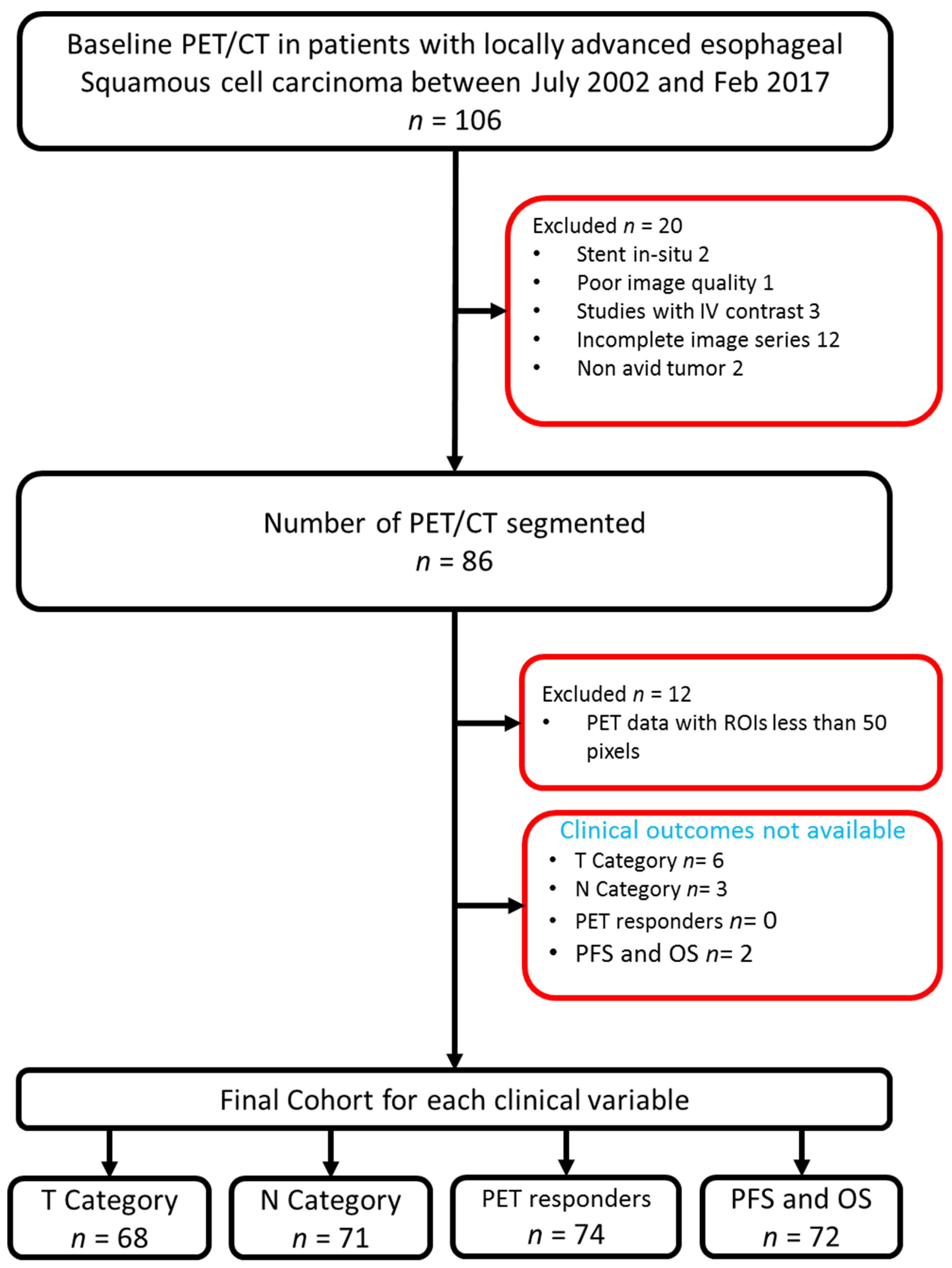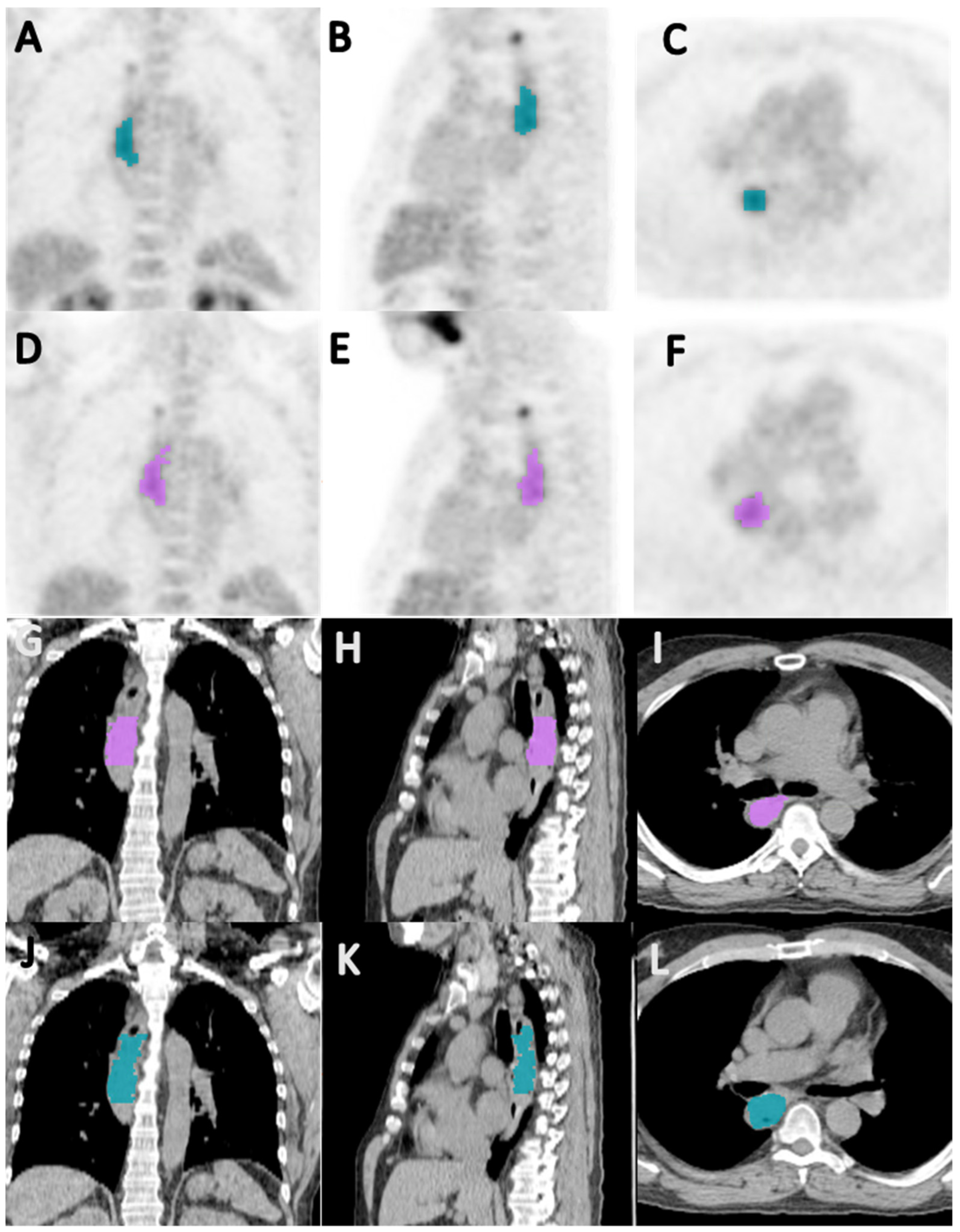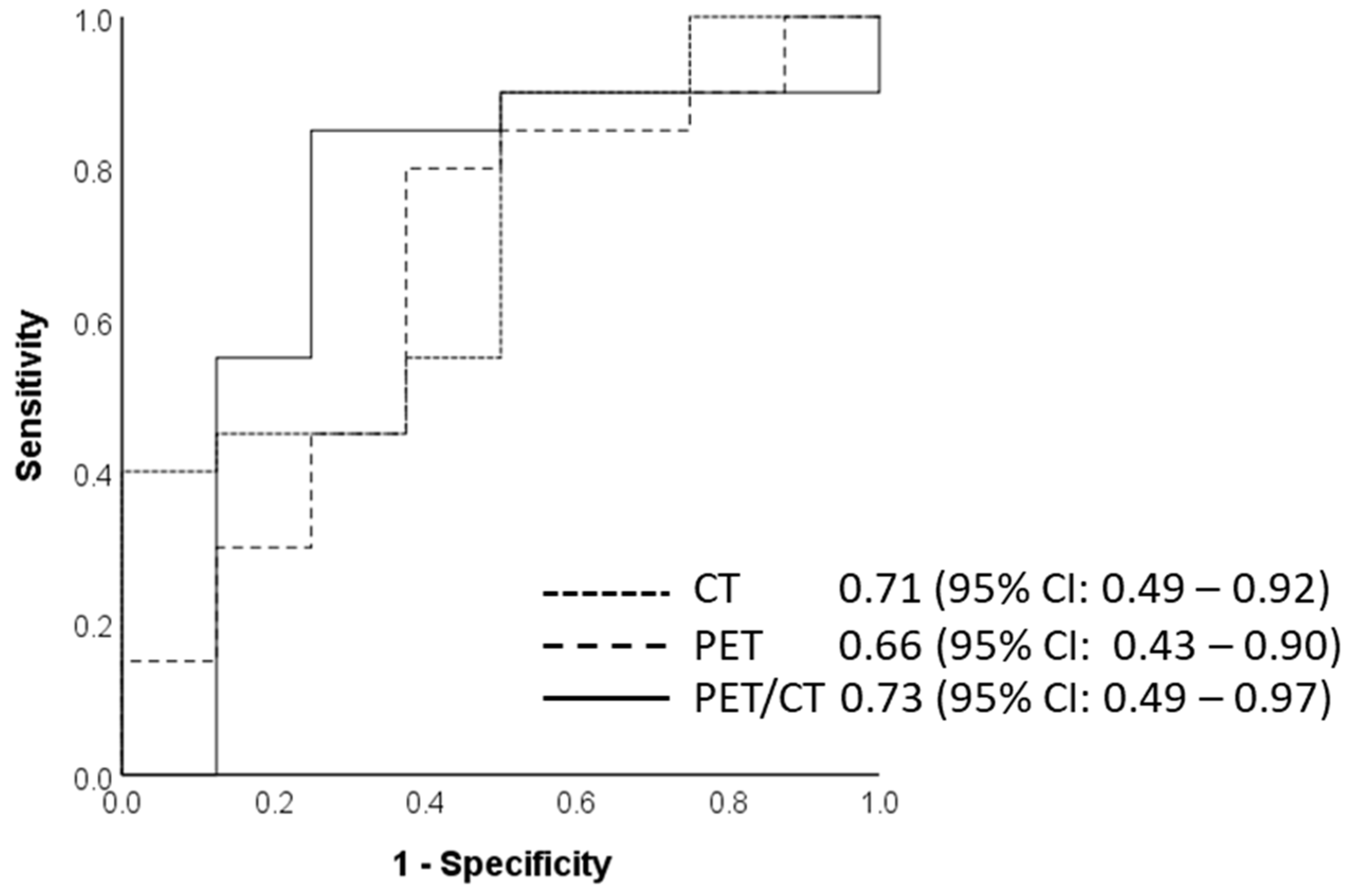Can 18F-FDG PET/CT Radiomics Features Predict Clinical Outcomes in Patients with Locally Advanced Esophageal Squamous Cell Carcinoma?
Abstract
:Simple Summary
Abstract
1. Introduction
2. Materials and Methods
2.1. Patient Inclusion
2.2. Treatment and Imaging
2.3. Image Acquisition and Segmentation
2.4. Radiomics Analysis
2.5. Statistical Analysis
3. Results
3.1. Patient Characteristics
3.2. Diagnostic Accuracy of CT, PET, and Combined PET/CT Training and Test Datasets for Various Clinical Parameters
4. Discussion
5. Conclusions
Supplementary Materials
Author Contributions
Funding
Institutional Review Board Statement
Informed Consent Statement
Data Availability Statement
Acknowledgments
Conflicts of Interest
References
- Barber, T.W.; Duong, C.P.; Leong, T.; Bressel, M.; Drummond, E.G.; Hicks, R.J. 18F-FDG PET/CT has a high impact on patient management and provides powerful prognostic stratification in the primary staging of esophageal cancer: A prospective study with mature survival data. J. Nucl. Med. 2012, 53, 864–871. [Google Scholar] [CrossRef] [Green Version]
- Greally, M.; Chou, J.F.; Molena, D.; Rusch, V.W.; Bains, M.S.; Park, B.J.; Wu, A.J.; Goodman, K.A.; Kelsen, D.P.; Janjigian, Y.Y.; et al. Positron-Emission Tomography Scan-Directed Chemoradiation for Esophageal Squamous Cell Carcinoma: No Benefit for a Change in Chemotherapy in Positron-Emission Tomography Nonresponders. J. Thorac. Oncol. 2019, 14, 540–546. [Google Scholar] [CrossRef] [PubMed] [Green Version]
- Lordick, F.; Ott, K.; Krause, B.J.; Weber, W.A.; Becker, K.; Stein, H.J.; Lorenzen, S.; Schuster, T.; Wieder, H.; Herrmann, K.; et al. PET to assess early metabolic response and to guide treatment of adenocarcinoma of the oesophagogastric junction: The MUNICON phase II trial. Lancet Oncol. 2007, 8, 797–805. [Google Scholar] [CrossRef]
- Rizk, N.; Downey, R.J.; Akhurst, T.; Gonen, M.; Bains, M.S.; Larson, S.; Rusch, V. Preoperative 18[F]-fluorodeoxyglucose positron emission tomography standardized uptake values predict survival after esophageal adenocarcinoma resection. Ann. Thorac. Surg. 2006, 81, 1076–1081. [Google Scholar] [CrossRef]
- Korkmaz, U.; Hacioglu, M.B.; Kostek, O.; Sut, N.; Kodaz, H.; Erdogan, B.; Ustun, F.; Saynak, M.; Tastekin, E.; Cicin, I.; et al. The relationship between FDG PET/CT-defined metabolic parameters and the histopathological subtype of oesophageal carcinomas. Pol. J. Radiol. 2020, 85, e254–e260. [Google Scholar] [CrossRef] [PubMed]
- Chhabra, A.; Ong, L.T.; Kuk, D.; Ku, G.; Ilson, D.; Janjigian, Y.Y.; Wu, A.; Schöder, H.; Goodman, K.A. Prognostic significance of PET assessment of metabolic response to therapy in oesophageal squamous cell carcinoma. Br. J. Cancer 2015, 113, 1658–1665. [Google Scholar] [CrossRef]
- Schollaert, P.; Crott, R.; Bertrand, C.; D’Hondt, L.; Borght, T.V.; Krug, B. A systematic review of the predictive value of (18)FDG-PET in esophageal and esophagogastric junction cancer after neoadjuvant chemoradiation on the survival outcome stratification. J. Gastrointest. Surg. 2014, 18, 894–905. [Google Scholar] [CrossRef]
- Lambin, P.; Leijenaar, R.T.H.; Deist, T.M.; Peerlings, J.; de Jong, E.E.C.; van Timmeren, J.; Sanduleanu, S.; Larue, R.T.H.M.; Even, A.J.G.; Jochems, A.; et al. Radiomics: The bridge between medical imaging and personalized medicine. Nat. Rev. Clin. Oncol. 2017, 14, 749–762. [Google Scholar] [CrossRef] [PubMed]
- Gillies, R.J.; Kinahan, P.E.; Hricak, H. Radiomics: Images Are More than Pictures, They Are Data. Radiology 2016, 278, 563–577. [Google Scholar] [CrossRef] [Green Version]
- Scapicchio, C.; Gabelloni, M.; Barucci, A.; Cioni, D.; Saba, L.; Neri, E. A deep look into radiomics. Radiol. Med. 2021, 126, 1296–1311. [Google Scholar] [CrossRef]
- Park, J.E.; Kim, D.; Kim, H.S.; Park, S.Y.; Kim, J.Y.; Cho, S.J.; Shin, J.H.; Kim, J.H. Quality of science and reporting of radiomics in oncologic studies: Room for improvement according to radiomics quality score and TRIPOD statement. Eur. Radiol. 2020, 30, 523–536. [Google Scholar] [CrossRef]
- Gabelloni, M.; Faggioni, L.; Neri, E. Imaging biomarkers in upper gastrointestinal cancers. BJR Open 2019, 1, 20190001. [Google Scholar] [CrossRef]
- Beukinga, R.J.; Hulshoff, J.B.; Mul, V.E.M.; Noordzij, W.; Kats-Ugurlu, G.; Slart, R.H.J.A.; Plukker, J.T.M. Prediction of Response to Neoadjuvant Chemotherapy and Radiation Therapy with Baseline and Restaging 18 F-FDG PET Imaging Biomarkers in Patients with Esophageal Cancer. Radiology 2018, 287, 983–992. [Google Scholar] [CrossRef] [Green Version]
- Yang, Z.; He, B.; Zhuang, X.; Gao, X.; Wang, D.; Li, M.; Lin, Z.; Luo, R. CT-based radiomic signatures for prediction of pathologic complete response in esophageal squamous cell carcinoma after neoadjuvant chemoradiotherapy. J. Radiat. Res. 2019, 60, 538–545. [Google Scholar] [CrossRef] [Green Version]
- Hu, Y.; Xie, C.; Yang, H.; Ho, J.W.K.; Wen, J.; Han, L.; Chiu, K.W.H.; Fu, J.; Vardhanabhuti, V. Assessment of Intratumoral and Peritumoral Computed Tomography Radiomics for Predicting Pathological Complete Response to Neoadjuvant Chemoradiation in Patients With Esophageal Squamous Cell Carcinoma. JAMA Netw. Open 2020, 3, e2015927. [Google Scholar] [CrossRef]
- Wu, L.; Yang, X.; Cao, W.; Zhao, K.; Li, W.; Ye, W.; Chen, X.; Zhou, Z.; Liu, Z.; Liang, C. Multiple Level CT Radiomics Features Preoperatively Predict Lymph Node Metastasis in Esophageal Cancer: A Multicentre Retrospective Study. Front. Oncol. 2019, 9, 1548. [Google Scholar] [CrossRef] [PubMed]
- Wu, L.; Wang, C.; Tan, X.; Cheng, Z.; Zhao, K.; Yan, L.; Liang, Y.; Liu, Z.; Liang, C. Radiomics approach for preoperative identification of stages I−II and III−IV of esophageal cancer. Chin. J. Cancer Res. 2018, 30, 396–405. [Google Scholar] [CrossRef]
- Tan, X.; Ma, Z.; Yan, L.; Ye, W.; Liu, Z.; Liang, C. Radiomics nomogram outperforms size criteria in discriminating lymph node metastasis in resectable esophageal squamous cell carcinoma. Eur. Radiol. 2019, 29, 392–400. [Google Scholar] [CrossRef]
- Larue, R.T.H.M.; Klaassen, R.; Jochems, A.; Leijenaar, R.T.H.; Hulshof, M.C.C.M.; van Berge Henegouwen, M.I.; Schreurs, W.M.J.; Sosef, M.N.; van Elmpt, W.; van Laarhoven, H.W.M.; et al. Pre-treatment CT radiomics to predict 3-year overall survival following chemoradiotherapy of esophageal cancer. Acta Oncol. 2018, 57, 1475–1481. [Google Scholar] [CrossRef] [Green Version]
- Xie, C.; Yang, P.; Zhang, X.; Xu, L.; Wang, X.; Li, X.; Zhang, L.; Xie, R.; Yang, L.; Jing, Z.; et al. Sub-region based radiomics analysis for survival prediction in oesophageal tumours treated by definitive concurrent chemoradiotherapy. EBioMedicine 2019, 44, 289–297. [Google Scholar] [CrossRef] [Green Version]
- Ott, K.; Weber, W.A.; Lordick, F.; Becker, K.; Busch, R.; Herrmann, K.; Wieder, H.; Fink, U.; Schwaiger, M.; Siewert, J.R. Metabolic imaging predicts response, survival, and recurrence in adenocarcinomas of the esophagogastric junction. J. Clin. Oncol. 2006, 24, 4692–4698. [Google Scholar] [CrossRef] [PubMed]
- Apte, A.P.; Iyer, A.; Crispin-Ortuzar, M.; Pandya, R.; van Dijk, L.V.; Spezi, E.; Thor, M.; Um, H.; Veeraraghavan, H.; Oh, J.H.; et al. Technical Note: Extension of CERR for computational radiomics: A comprehensive MATLAB platform for reproducible radiomics research. Med. Phys. 2018, 45, 3713–3720. [Google Scholar] [CrossRef] [PubMed]
- He, H.; Bai, Y.; Garcia, E.A.; Li, S. ADASYN: Adaptive synthetic sampling approach for imbalanced learning. In Proceedings of the 2008 IEEE International Joint Conference on Neural Networks (IEEE World Congress on Computational Intelligence), Hong Kong, China, 1–8 June 2008; pp. 1322–1328. [Google Scholar] [CrossRef] [Green Version]
- Militello, C.; Rundo, L.; Dimarco, M.; Orlando, A.; Woitek, R.; D’Angelo, I.; Russo, G.; Bartolotta, T.V. 3D DCE-MRI Radiomic Analysis for Malignant Lesion Prediction in Breast Cancer Patients. Acad Radiol. 2022, 29, 830–840. [Google Scholar] [CrossRef]
- Luo, L.-N.; He, L.-J.; Gao, X.-Y.; Huang, X.-X.; Shan, H.-B.; Luo, G.-Y.; Li, Y.; Lin, S.-Y.; Wang, G.-B.; Zhang, R.; et al. Endoscopic Ultrasound for Preoperative Esophageal Squamous Cell Carcinoma: A Meta-Analysis. PLoS ONE 2016, 11, e0158373. [Google Scholar] [CrossRef] [Green Version]
- Yang, M.; Hu, P.; Li, M.; Ding, R.; Wang, Y.; Pan, S.; Kang, M.; Kong, W.; Du, D.; Wang, F. Computed Tomography-Based Radiomics in Predicting T Stage and Length of Esophageal Squamous Cell Carcinoma. Front. Oncol. 2021, 11, 722961. [Google Scholar] [CrossRef]
- Mantziari, S.; Pomoni, A.; Prior, J.O.; Winiker, M.; Allemann, P.; Demartines, N.; Schäfer, M. (18)F- FDG PET/CT-derived parameters predict clinical stage and prognosis of esophageal cancer. BMC Med. Imaging 2020, 20, 7. [Google Scholar] [CrossRef] [Green Version]
- Foley, K.G.; Christian, A.; Fielding, P.; Lewis, W.G.; Roberts, S.A. Accuracy of contemporary oesophageal cancer lymph node staging with radiological-pathological correlation. Clin. Radiol. 2017, 72, 693.e1–693.e7. [Google Scholar] [CrossRef] [Green Version]
- Shen, C.; Liu, Z.; Wang, Z.; Guo, J.; Zhang, H.; Wang, Y.; Qin, J.; Li, H.; Fang, M.; Tang, Z.; et al. Building CT Radiomics Based Nomogram for Preoperative Esophageal Cancer Patients Lymph Node Metastasis Prediction. Transl. Oncol. 2018, 11, 815–824. [Google Scholar] [CrossRef]
- Lee, S.; Choi, Y.; Park, G.; Jo, S.; Lee, S.S.; Park, J.; Shim, H.K. (18)F-FDG PET/CT Parameters for Predicting Prognosis in Esophageal Cancer Patients Treated With Concurrent Chemoradiotherapy. Technol. Cancer Res. Treat. 2021, 20, 15330338211024655. [Google Scholar] [CrossRef]
- Han, S.; Kim, Y.J.; Woo, S.; Suh, C.H.; Lee, J.J. Prognostic Value of Volumetric Parameters of Pretreatment 18F-FDG PET/CT in Esophageal Cancer: A Systematic Review and Meta-analysis. Clin. Nucl. Med. 2018, 43, 887–894. [Google Scholar] [CrossRef]
- Gopal, A.; Xi, Y.; Subramaniam, R.M.; Pinho, D.F. Intratumoral Metabolic Heterogeneity and Other Quantitative (18)F-FDG PET/CT Parameters for Prognosis Prediction in Esophageal Cancer. Radiol. Imaging Cancer 2020, 3, e200022. [Google Scholar] [CrossRef]
- Qiu, Q.; Duan, J.; Deng, H.; Han, Z.; Gu, J.; Yue, N.J.; Yin, Y. Development and Validation of a Radiomics Nomogram Model for Predicting Postoperative Recurrence in Patients with Esophageal Squamous Cell Cancer Who Achieved pCR After Neoadjuvant Chemoradiotherapy Followed by Surgery. Front. Oncol. 2020, 10, 1398. [Google Scholar] [CrossRef] [PubMed]
- Luo, H.-S.; Chen, Y.-Y.; Huang, W.-Z.; Wu, S.-X.; Huang, S.-F.; Xu, H.-Y.; Xue, R.-L.; Du, Z.-S.; Li, X.-Y.; Lin, L.-X.; et al. Development and validation of a radiomics-based model to predict local progression-free survival after chemo-radiotherapy in patients with esophageal squamous cell cancer. Radiat. Oncol. 2021, 16, 201. [Google Scholar] [CrossRef] [PubMed]
- Lu, N.; Zhang, W.-J.; Dong, L.; Chen, J.-Y.; Zhu, Y.-L.; Zhang, S.-H.; Fu, J.-H.; Yin, S.-H.; Li, Z.-C.; Xie, C.-M. Dual-region radiomics signature: Integrating primary tumor and lymph node computed tomography features improves survival prediction in esophageal squamous cell cancer. Comput. Methods Programs Biomed. 2021, 208, 106287. [Google Scholar] [CrossRef]
- Rice, T.W.; Ishwaran, H.; Ferguson, M.K.; Blackstone, E.H.; Goldstraw, P. Cancer of the Esophagus and Esophagogastric Junction: An Eighth Edition Staging Primer. J. Thorac. Oncol. 2017, 12, 36–42. [Google Scholar] [CrossRef] [Green Version]
- Stahl, M.; Stuschke, M.; Lehmann, N.; Meyer, H.J.; Walz, M.K.; Seeber, S.; Klump, B.; Budach, W.; Teichmann, R.; Schmitt, M.; et al. Chemoradiation with and without surgery in patients with locally advanced squamous cell carcinoma of the esophagus. J. Clin. Oncol. 2005, 23, 2310–2317. [Google Scholar] [CrossRef] [Green Version]
- Bedenne, L.; Michel, P.; Bouché, O.; Milan, C.; Mariette, C.; Conroy, T.; Pezet, D.; Roullet, B.; Seitz, J.F.; Herr, J.P.; et al. Chemoradiation followed by surgery compared with chemoradiation alone in squamous cancer of the esophagus: FFCD 9102. J. Clin. Oncol. 2007, 25, 1160–1168. [Google Scholar] [CrossRef] [Green Version]





| Scanners | Number of Scans |
| GE Discovery 690 | 13 |
| GE Discovery 710 | 5 |
| GE Discovery LS | 10 |
| GE Discovery QX/i | 2 |
| GE Discovery ST | 7 |
| GE Discovery STE | 14 |
| Philips Gemini TF TOF 64 | 1 |
| Siemens Biograph 40 | 3 |
| Siemens Biograph 6 | 8 |
| Siemens Emotion Duo | 6 |
| Siemens Sensation 16 | 5 |
| CT parameters | Median (range) |
| kVp (kV) | 130 (100–140) |
| Tube current (mA) | 85 (35–305) |
| Matrix size | All at 512 × 512 |
| In-plane resolution | 0.977 (0.775–1.523) |
| Slice thickness | 3.8 (3.0–5.0) |
| PET parameters | Median (range) |
| Matrix size | 128 × 128 (128 × 128 to 484 × 484) |
| In-plane resolution (mm) | 5.31 (1.03–5.47) |
| Slice thickness (mm) | 3.3 (2.0–5.0) |
| Dose (MBq) | 458 (320–788) |
| Uptake time (min) | 65 (45–91) |
| Patient Characteristic | Male | Female | Total or p-Value |
|---|---|---|---|
| Total | 51 | 23 | 74 |
| Mean Age ± SD | 65 (45–87) | 66 (41–84) | 0.852 |
| Nodal Category (AJCC 8th) | |||
| N0 | 6 | 7 | 0.049 |
| N1/2 | 43 | 15 | |
| Tumor Category (AJCC 8th) | |||
| T2 | 7 | 1 | 0.201 |
| T3/4 | 39 | 21 | |
| PET Responders | |||
| No | 17 | 8 | 0.903 |
| Yes | 34 | 15 | |
| Progression-Free Survival | |||
| Yes | 15 | 6 | 0.694 |
| No | 34 | 17 | |
| Overall Survival (3 Yrs) | |||
| Yes | 20 | 10 | 0.831 |
| No | 29 | 13 | |
| Induction Chemotherapy | 51 | 23 | 74 |
| Capecitabine/Oxaliplatin | 0 | 1 | |
| Carboplatin/Irinotecan | 1 | 0 | |
| Carboplatin/Paclitaxel | 30 | 15 | |
| Cisplatin/Irinotecan | 18 | 5 | |
| Cisplatin/Irinotecan/Docetaxel | 1 | 1 | |
| Docetaxel/Irinotecan | 1 | 1 | |
| Change in Chemo Regimen Post-Induction PET/CT | |||
| Yes | 10 | 6 | 16 |
| No | 41 | 17 | 58 |
| SUVmax | 12.55 (10.01–15.64) | 12.51 (9.32–16.64) | 0.931 |
| Clinical Parameters | Total | Training Cases | Test Cases |
|---|---|---|---|
| Nodal Category | |||
| N0 | 13 | 7 | 6 |
| N1/2 | 58 | 35 | 23 |
| Tumor Category | |||
| T2 | 8 | 5 | 3 |
| T3/4 | 60 | 36 | 24 |
| PET Responders | |||
| Yes | 49 | 29 | 20 |
| No | 25 | 15 | 10 |
| Progression-Free Survival | |||
| Yes | 28 | 20 | 8 |
| No | 44 | 31 | 13 |
| Overall Survival (3 Yrs) | |||
| Yes | 30 | 18 | 12 |
| No | 42 | 25 | 17 |
| Clinical Parameter | Training CT Dataset | Test CT Dataset | Training PET Dataset | Test PET Dataset | Training Combined PET/CT Dataset | Test Combined PET/CT Dataset |
|---|---|---|---|---|---|---|
| Nodal Category | 64.3 (51.9–75.4) | 69.0 (49.2–84.7) | 85.7 (75.3–92.9) | 86.2 (68.3–96.1 | 87.1 (77.0–94.0) | 86.2 (68.3–96.1) |
| Tumor Category | 90.3 (81.0–96.0) | 70.4 (49.8–86.3) | 83.3 (72.7–92.1) | 70.4 (49.8–86.3) | 83.3 (72.7–91.1) | 81.5 (61.9–93.7) |
| PET Responders | 69.0 (55.5–80.5) | 60.0 (40.6–77.3) | 72.4 (59.1–83.3) | 66.7 (47.2–82.7) | 75.9 (62.8–86.1) | 70.0 (50.6–85.3) |
| Progression-Free Survival | 66.1 (53.0–77.7) | 60.7 (40.6–78.5) | 77.4 (65.0–87.1) | 75.0 (55.1–89.3) | 77.4 (65.0–87.1) | 75.0 (55.1–89.3) |
| Overall Survival (3 Yrs) | 56.0 (41.3–70.0) | 51.7 (32.6–70.6) | 58.0 (43.2–71.8) | 55.2 (35.7–73.6) | 68.0 (53.3–80.5) | 62.1 (42.3–79.3) |
Publisher’s Note: MDPI stays neutral with regard to jurisdictional claims in published maps and institutional affiliations. |
© 2022 by the authors. Licensee MDPI, Basel, Switzerland. This article is an open access article distributed under the terms and conditions of the Creative Commons Attribution (CC BY) license (https://creativecommons.org/licenses/by/4.0/).
Share and Cite
Jayaprakasam, V.S.; Gibbs, P.; Gangai, N.; Bajwa, R.; Sosa, R.E.; Yeh, R.; Greally, M.; Ku, G.Y.; Gollub, M.J.; Paroder, V. Can 18F-FDG PET/CT Radiomics Features Predict Clinical Outcomes in Patients with Locally Advanced Esophageal Squamous Cell Carcinoma? Cancers 2022, 14, 3035. https://doi.org/10.3390/cancers14123035
Jayaprakasam VS, Gibbs P, Gangai N, Bajwa R, Sosa RE, Yeh R, Greally M, Ku GY, Gollub MJ, Paroder V. Can 18F-FDG PET/CT Radiomics Features Predict Clinical Outcomes in Patients with Locally Advanced Esophageal Squamous Cell Carcinoma? Cancers. 2022; 14(12):3035. https://doi.org/10.3390/cancers14123035
Chicago/Turabian StyleJayaprakasam, Vetri Sudar, Peter Gibbs, Natalie Gangai, Raazi Bajwa, Ramon E. Sosa, Randy Yeh, Megan Greally, Geoffrey Y. Ku, Marc J. Gollub, and Viktoriya Paroder. 2022. "Can 18F-FDG PET/CT Radiomics Features Predict Clinical Outcomes in Patients with Locally Advanced Esophageal Squamous Cell Carcinoma?" Cancers 14, no. 12: 3035. https://doi.org/10.3390/cancers14123035
APA StyleJayaprakasam, V. S., Gibbs, P., Gangai, N., Bajwa, R., Sosa, R. E., Yeh, R., Greally, M., Ku, G. Y., Gollub, M. J., & Paroder, V. (2022). Can 18F-FDG PET/CT Radiomics Features Predict Clinical Outcomes in Patients with Locally Advanced Esophageal Squamous Cell Carcinoma? Cancers, 14(12), 3035. https://doi.org/10.3390/cancers14123035






